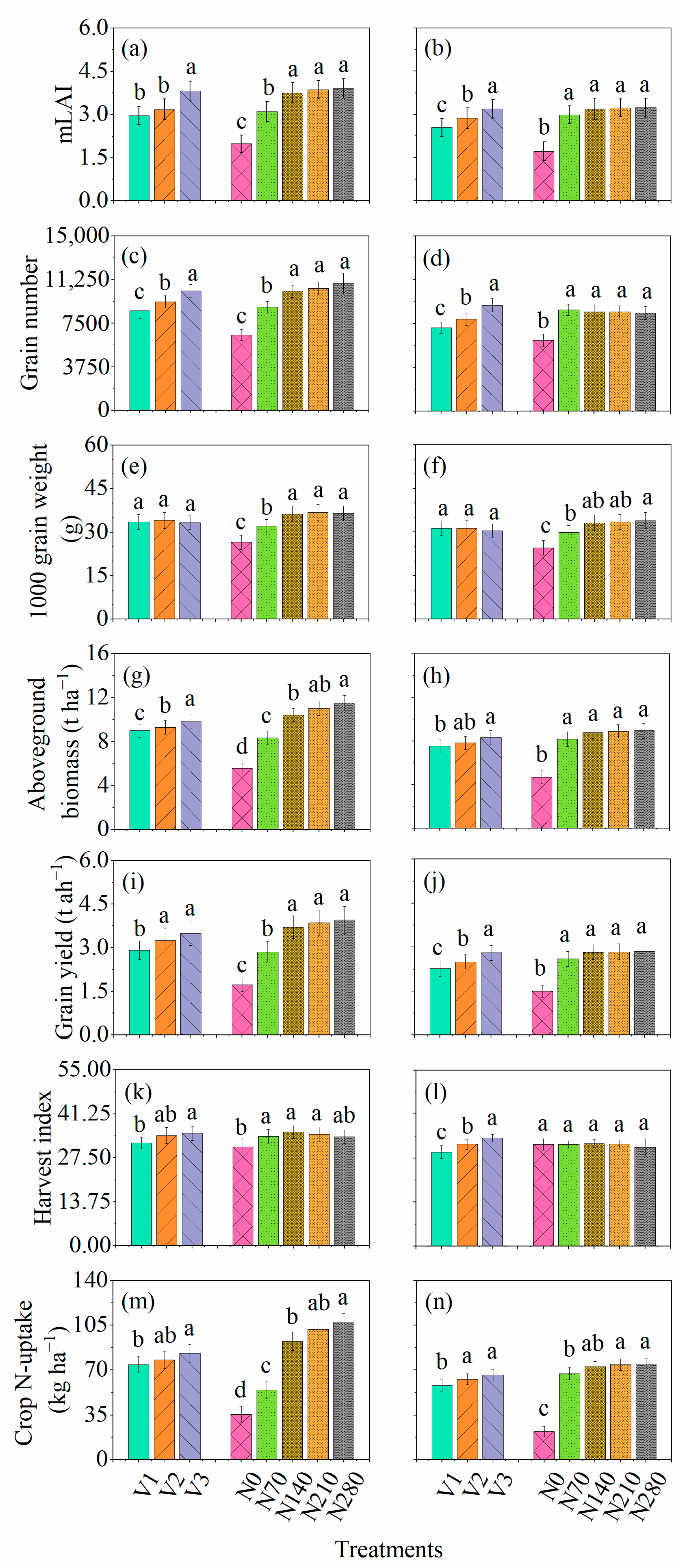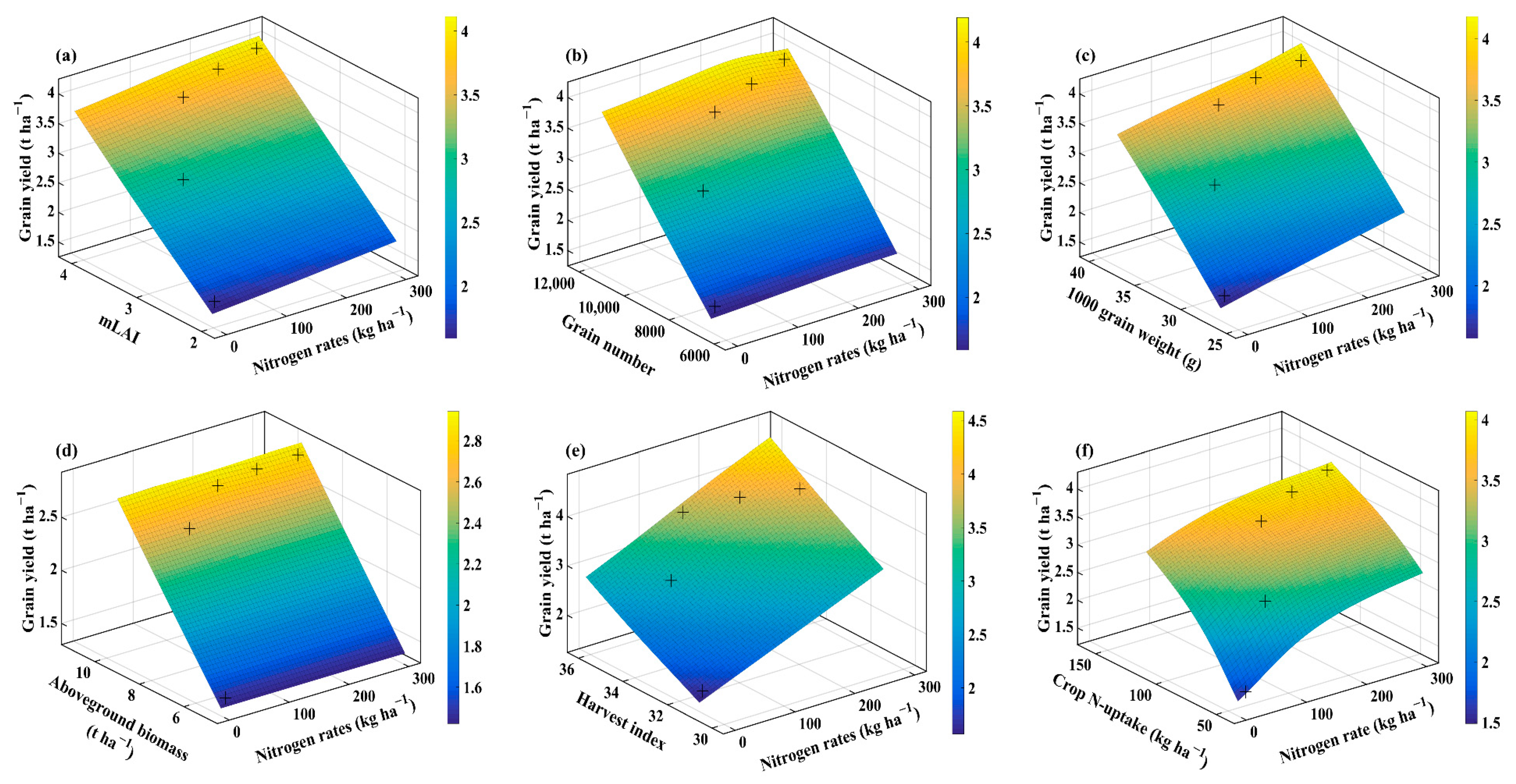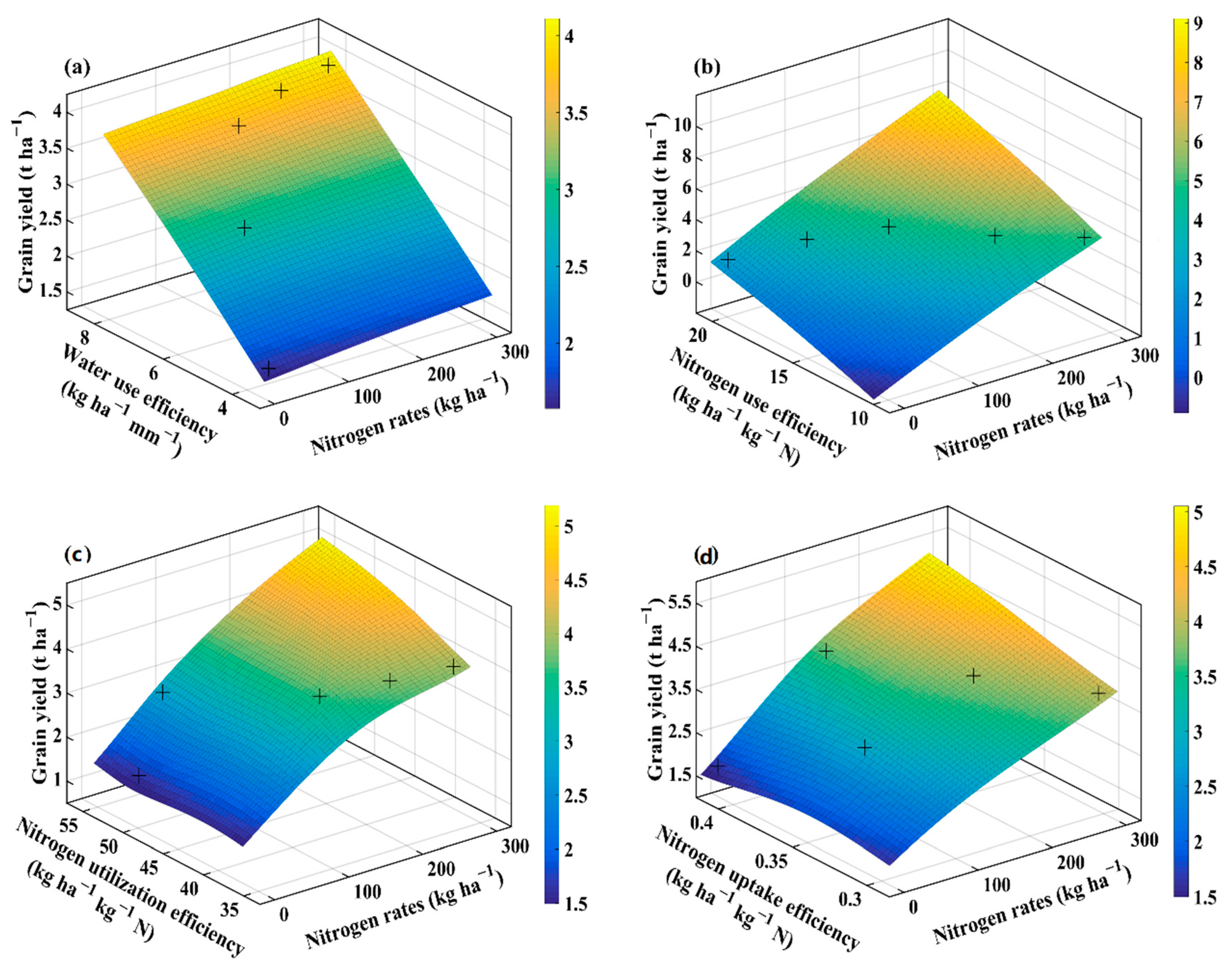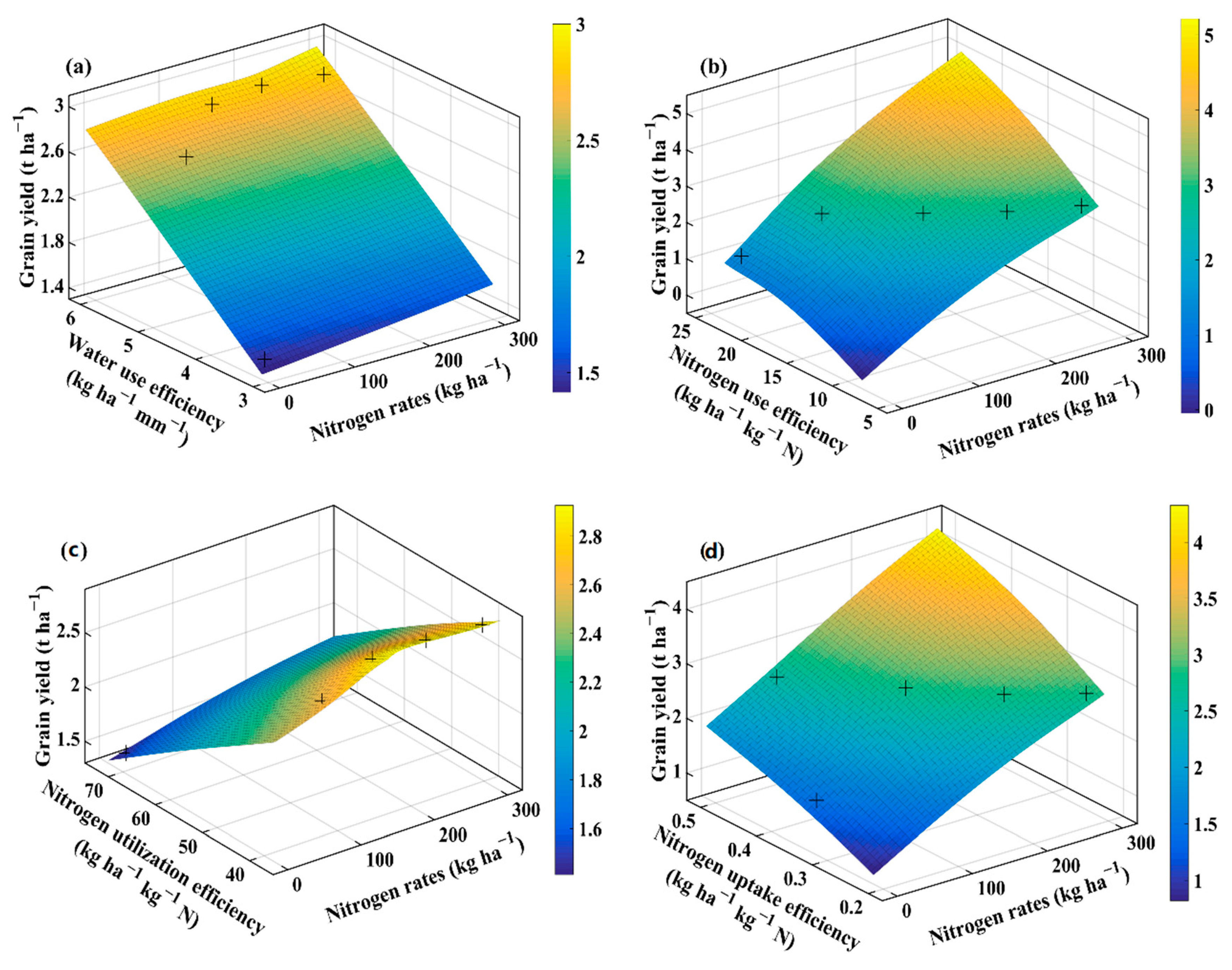Exploring the Impacts of Genotype-Management-Environment Interactions on Wheat Productivity, Water Use Efficiency, and Nitrogen Use Efficiency under Rainfed Conditions
Abstract
:1. Introduction
2. Results
2.1. Weather Conditions
2.2. Effect of Genotype, Weather, and Nitrogen Application Rates on Agronomic Traits
2.3. Effect of Genotype, Weather, and Nitrogen Application Rates on Water and Nitrogen Use Efficiencies
2.4. Interaction of Agronomic Traits, Water Use Efficiency, and Nitrogen Efficiencies Using Thin Plate Smoothing Spline
3. Discussion
4. Materials and Methods
4.1. Field Experiments
4.2. Weather and Soil Data
4.3. Measurement of Crop Parameters
4.4. Statistical Analysis
5. Conclusions
Supplementary Materials
Author Contributions
Funding
Data Availability Statement
Acknowledgments
Conflicts of Interest
References
- FAOSTAT. Food and Agriculture Organization of the United Nations. 2021. Available online: http://www.fao.org/faostat/en/#data/QC (accessed on 23 June 2021).
- Baig, M.B.; Shahid, S.A.; Straquadine, G.S. Making rainfed agriculture sustainable through environmental friendly technologies in Pakistan: A review. Int. Soil Water Conserv. Res. 2013, 1, 36–52. [Google Scholar] [CrossRef] [Green Version]
- Stocker, T. Climate Change 2013: The Physical Science Basis: Working Group I Contribution to the Fifth Assessment Report of the Intergovernmental Panel on Climate Change; Cambridge University Press: New York, NY, USA, 2014; ISBN 978-1-107-05799-9. [Google Scholar]
- Ahmad, A.; Ashfaq, M.; Rasul, G.; Wajid, S.A.; Khaliq, T.; Rasul, F.; Saeed, U.; ur Rahman, M.H.; Hussain, J.; Ahmad Baig, I. Impact of climate change on the rice—wheat cropping system of Pakistan. In Handbook of Climate Change and Agroecosystems; The Agricultural Model Intercomparison and Improvement Project Integrated Crop and Economic Assessments, Part 2; Imperial College Press: London, UK, 2015; pp. 219–258. [Google Scholar]
- Bradford, J.B.; Schlaepfer, D.R.; Lauenroth, W.K.; Yackulic, C.B.; Duniway, M.; Hall, S.; Jia, G.; Jamiyansharav, K.; Munson, S.M.; Wilson, S.D.; et al. Future soil moisture and temperature extremes imply expanding suitability for rainfed agriculture in temperate drylands. Sci. Rep. 2017, 7, 1–11. [Google Scholar] [CrossRef] [Green Version]
- Sadras, V.O.; Hayman, P.T.; Rodriguez, D.; Monjardino, M.; Bielich, M.; Unkovich, M.; Mudge, B.; Wang, E. Interactions between water and nitrogen in Australian cropping systems: Physiological, agronomic, economic, breeding and modelling perspectives. Crop Pasture Sci. 2016, 67, 1019–1053. [Google Scholar] [CrossRef] [Green Version]
- Sadras, V. Interaction between rainfall and nitrogen fertilisation of wheat in environments prone to terminal drought: Economic and environmental risk analysis. Field Crops Res. 2002, 77, 201–215. [Google Scholar] [CrossRef]
- Basso, B.; Cammarano, D.; Troccoli, A.; Chen, D.; Ritchie, J.T. Long-term wheat response to nitrogen in a rainfed Mediterranean environment: Field data and simulation analysis. Eur. J. Agron. 2010, 33, 132–138. [Google Scholar] [CrossRef]
- Costa, J.S.P.; Mantai, R.D.; da Silva, J.A.G.; Scremin, O.B.; Arenhardt, E.G.; de Lima, A.R.C. Single and split nitrogen dose in wheat yield indicators. Rev. Bras. Eng. Agríc. Ambient. 2018, 22, 16–21. [Google Scholar] [CrossRef] [Green Version]
- Norton, R.M. Nitrogen management to optimise canola production in Australia. Crop Pasture Sci. 2016, 67, 419–438. [Google Scholar] [CrossRef]
- Riar, A.; Gill, G.; McDonald, G.K. Rate of Nitrogen Rather Than Timing of Application Influence Yield and NUE of Canola in South Australian Mediterranean Environments. Agronomy 2020, 10, 1505. [Google Scholar] [CrossRef]
- Irmak, S.; Djaman, K.; Sharma, V. Winter wheat (Triticum aestivum L.) evapotranspiration and single (normal) and basal crop coefficients. Trans. ASABE 2015, 58, 1047–1066. [Google Scholar] [CrossRef]
- Asseng, S.; Turner, N.C.; Keating, B.A. Analysis of water-and nitrogen-use efficiency of wheat in a Mediterranean climate. Plant Soil. 2001, 233, 127–143. [Google Scholar] [CrossRef]
- Farooq, M.; Bramley, H.; Palta, J.A.; Siddique, K.H.M. Heat stress in wheat during reproductive and grain-filling phases. Crit. Rev. Plant Sci. 2011, 30, 491–507. [Google Scholar] [CrossRef]
- renhardt, E.G.; da Silva, J.A.G.; Gewehr, E.; de Oliveira, A.C.; Binelo, M.O.; Valdiero, A.C.; Gzergorczick, M.E.; de Lima, A.R.C.; da Silva, J.; Antonio, G. The nitrogen supply in wheat cultivation dependent on weather conditions and succession system in southern Brazil. Afr. J. Agric. Res. 2015, 10, 4322–4330. [Google Scholar] [CrossRef]
- Cossani, C.M.; Sadras, V.O. Nitrogen and water supply modulate the effect of elevated temperature on wheat yield. Eur. J. Agron. 2021, 124, 126227. [Google Scholar] [CrossRef]
- Hammad, H.M.; Abbas, F.; Saeed, S.; Fahad, S.; Cerdà, A.; Farhad, W.; Bernardo, C.C.; Nasim, W.; Mubeen, M.; Bakhat, H.F. Offsetting land degradation through nitrogen and water management during maize cultivation under arid conditions. Land Degrad. Dev. 2018, 29, 1366–1375. [Google Scholar] [CrossRef]
- Ata-Ul-Karim, S.T.; Cang, L.; Wang, Y.; Zhou, D. Interactions between nitrogen application and soil properties and their impacts on the transfer of cadmium from soil to wheat (Triticum aestivum L.) grain. Geoderma 2019, 357, 113923. [Google Scholar] [CrossRef]
- Ata-Ul-Karim, S.T.; Cang, L.; Wang, Y.; Zhou, D. Effects of soil properties, nitrogen application, plant phenology, and their interactions on plant uptake of cadmium in wheat. J. Hazard. Mater. 2019, 384, 121452. [Google Scholar] [CrossRef]
- Sadras, V.O.; Lawson, C.; Hooper, P.; McDonald, G.K. Contribution of summer rainfall and nitrogen to the yield and water use efficiency of wheat in Mediterranean-type environments of South Australia. Eur. J. Agron. 2012, 36, 41–54. [Google Scholar] [CrossRef]
- Hochman, Z.; Carberry, P.S. Emerging consensus on desirable characteristics of tools to support farmers’ management of climate risk in Australia. Agric. Syst. 2011, 104, 441–450. [Google Scholar] [CrossRef]
- Qadeer, U.; Ahmed, M.; Hassan, F.-u.; Akmal, M. Impact of nitrogen addition on physiological, crop total nitrogen, efficiencies and agronomic traits of the wheat crop under rainfed conditions. Sustainability 2019, 11, 6486. [Google Scholar] [CrossRef] [Green Version]
- Sedri, M.H.; Amini, A.; Golchin, A. Evaluation of nitrogen effects on yield and drought tolerance of rainfed wheat using drought stress indices. J. Crop Sci. Biotechnol. 2019, 22, 235–242. [Google Scholar] [CrossRef]
- Sattar, A.; Sher, A.; Ijaz, M.; Ullah, M.S.; Ahmad, N.; Umar, U.U. Individual and combined effect of terminal drought and heat stress on allometric growth, grain yield and quality of bread wheat. Pak. J. Bot. 2020, 52, 405–412. [Google Scholar] [CrossRef]
- Mäkinen, H.; Kaseva, J.; Trnka, M.; Balek, J.; Kersebaum, K.C.; Nendel, C.; Gobin, A.; Olesen, J.E.; Bindi, M.; Ferrise, R.; et al. Sensitivity of European wheat to extreme weather. Field Crops Res. 2018, 222, 209–217. [Google Scholar] [CrossRef]
- Mi, G.; Tang, L.; Zhang, F.; Zhang, J. Is nitrogen uptake after anthesis in wheat regulated by sink size? Field Crops Res. 2000, 68, 183–190. [Google Scholar] [CrossRef]
- Hu, C.; Sadras, V.O.; Lu, G.; Jin, X.; Xu, J.; Ye, Y.; Yang, X.; Zhang, S. Dual-purpose winter wheat: Interactions between crop management, availability of nitrogen and weather conditions. Field Crops Res. 2019, 241, 107579. [Google Scholar] [CrossRef]
- Sadras, V.O.; Angus, J.F. Benchmarking water-use efficiency of rainfed wheat in dry environments. Aust. J. Agric. Res. 2006, 57, 847–856. [Google Scholar] [CrossRef]
- Patanita, M.; Tomaz, A.; Ramos, T.; Oliveira, P.; Boteta, L.; Dôres, J. Water regime and nitrogen management to cope with wheat yield variability under the Mediterranean conditions of southern Portugal. Plants 2019, 8, 429. [Google Scholar] [CrossRef] [PubMed] [Green Version]
- Cossani, C.M.; Slafer, G.A.; Savin, R. Nitrogen and water use efficiencies of wheat and barley under a Mediterranean environment in Catalonia. Field Crops Res. 2012, 128, 109–118. [Google Scholar] [CrossRef]
- Cossani, C.M.; Thabet, C.; Mellouli, H.J.; Slafer, G.A. Improving wheat yields through N fertilization in Mediterranean Tunisia. Exp. Agric. 2011, 47, 459. [Google Scholar] [CrossRef]
- Kappen, L.; Schultz, G.; Gruler, T.; Widmoser, P. Effects of N-fertilization on shoots and roots of rape (Brassica napus L.) and consequences for the soil matric potential. J. Plant. Nutr. Soil Sci. 2000, 163, 481–489. [Google Scholar] [CrossRef]
- Yousaf, M.I.; Akhtar, N.; Mumtaz, A.; Akbar, W.; Javeed, H.M.; Bhatti, M.H.; Mehmood, A. Contribution of spike-related traits for grain yield in spring wheat. J. Agric. Basic Sci. 2017, 2, 30–36. [Google Scholar]
- Robertson, M.J.; Kirkegaard, J.A. Water-use efficiency of dryland canola in an equi-seasonal rainfall environment. Aust. J. Agric. Res. 2006, 56, 1373–1386. [Google Scholar] [CrossRef]
- Xu, A.; Li, L.; Xie, J.; Wang, X.; Coulter, J.A.; Liu, C.; Wang, L. Effect of long-term nitrogen addition on wheat yield, nitrogen use efficiency, and residual soil nitrate in a semiarid area of the loess plateau of China. Sustainability 2020, 12, 1735. [Google Scholar] [CrossRef] [Green Version]
- Todeschini, M.H.; Milioli, A.S.; Trevizan, D.M.; Bornhofen, E.; Finatto, T.; Storck, L.; Benin, G. Nitrogen use efficiency in modern wheat cultivars. Bragantia 2016, 75, 351–361. [Google Scholar] [CrossRef] [Green Version]
- Plaza-Bonilla, D.; Lampurlanés, J.; Fernández, F.G.; Cantero-Martínez, C. Nitrogen fertilization strategies for improved Mediterranean rainfed wheat and barley performance and water and nitrogen use efficiency. Eur. J. Agron. 2021, 124, 126238. [Google Scholar] [CrossRef]
- Culman, S.W.; Snapp, S.S.; Ollenburger, M.; Basso, B.; DeHaan, L.R. Soil and water quality rapidly responds to the perennial grain Kernza wheatgrass. J. Agron. 2013, 105, 735–744. [Google Scholar] [CrossRef] [Green Version]
- Sadras, V.O.; Lawson, C. Nitrogen and water-use efficiency of Australian wheat varieties released between 1958 and 2007. Eur. J. Agron. 2013, 46, 34–41. [Google Scholar] [CrossRef]
- Lassaletta, L.; Billen, G.; Grizzetti, B.; Anglade, J.; Garnier, J. 50 year trends in nitrogen use efficiency of world cropping systems: The relationship between yield and nitrogen input to cropland. Environ. Res. Lett. 2014, 9, 105011. [Google Scholar] [CrossRef]
- Hawkesford, M.J.; Riche, A.B. Impacts of G x E x M on nitrogen use efficiency in wheat and future prospects. Front. Plant Sci. 2020, 11, 1157. [Google Scholar] [CrossRef]
- Schmidt, J.P.; Hong, N.; Folmar, G.; Beegle, D.B.; Lin, H. Optimum nitrogen rate for corn increases with greater soil water availability. In Managing Crop Nitrogen for Weather; Bruulsema, T.W., Ed.; International Plant Nutrition Institute: Norcross, GA, USA, 2007. [Google Scholar]
- Yang, W.; Liu, W.; Li, Y.; Wang, S.; Yin, L.; Deng, X. Increasing rainfed wheat yield by optimizing agronomic practices to consume more subsoil water in the loess plateau. Crop J. 2021. [Google Scholar] [CrossRef]
- Baruah, T.C.; Barthakur, B.H. A Text Book of Soil Analysis; Vikas Publishing Houses Pvt, Ltd.: New Delhi, India, 1999. [Google Scholar]
- Bremner, J.M.; Mulvaney, C.S. Nitrogen-total. In Methods of Soil Analysis: Part 2 Chemical and Microbiological Properties; Page, A.L., Miller, R.H., Keeney, D.R., Eds.; American Society of Agronomy, Soil Science Society of America: Madison, WI, USA, 1982. [Google Scholar]
- Olson, K.; Ebelhar, S.A.; Lang, J.M. Long-term effects of cover crops on crop yields, soil organic carbon stocks and sequestration. Open J. Soil Sci. 2014, 2014, 48993. [Google Scholar] [CrossRef] [Green Version]
- Richards, L.A. Diagnosis and improvement of saline sodic and alkali soils. In USDA Agricultural Handbook 60; United States Department of Agriculture: Washington, DC, USA, 1954. [Google Scholar]
- Walkley, A.; Black, I.A. An examination of a rapid method for determination of organic carbon in sois-effect of variation in digestion conditions and inorganic soil constituents. Soil Sci. 1934, 63, 251–263. [Google Scholar] [CrossRef]
- Amanullah; Shah, S.; Shah, Z.; Khalail, S.K.; Jan, A.; Jan, M.T.; Afzal, M.; Akbar, H.; Khan, H.; Hidayat, U.R. Effects of variable nitrogen source and rate on leaf area index and total dry matter accumulation in maize (Zea mays L.) genotypes under calcareous soils. Turk. J. Field Crops 2014, 19, 276–284. [Google Scholar]
- Ahmad, S.; Ali, H.; Ur Rehman, A.; Khan, R.J.Z.; Ahmad, W.; Fatima, Z.; Abbas, G.; Irfan, M.; Ali, H.; Khan, M.A.; et al. Measuring leaf area of winter cereals by different techniques: A comparison. Pak. J. Life Soc. Sci. 2015, 13, 117–125. [Google Scholar]
- Zadoks, J.C.; Chang, T.T.; Konzak, C.F. A decimal code for the growth stages of cereals. Weed Res. 1974, 14, 415–421. [Google Scholar] [CrossRef]
- AOAC. Official Methods of Analysis, 14th ed.; Williams, S., Ed.; Association of Official Analytical Chemists Inc.: Arlington, VA, USA, 1984. [Google Scholar]







| mLAI | Grain Number | 1000 Grain Weight | Grain Yield | Aboveground Biomass | Harvest Index | Crop N-Uptake | WUE | NUE | NUtE | NUpE | |
|---|---|---|---|---|---|---|---|---|---|---|---|
| g | t ha−1 | t ha−1 | kg ha−1 | kg ha−1 mm−1 | kg ha−1 kg−1 N | kg ha−1 kg−1 N | kg ha−1 kg−1 N | ||||
| Season (S) | *** | *** | *** | *** | *** | *** | *** | *** | ** | ns | *** |
| Genotype (G) | *** | *** | ns | *** | *** | *** | *** | *** | *** | ns | *** |
| Nitrogen (N) | *** | *** | *** | *** | *** | * | *** | *** | *** | *** | *** |
| S × G | ns | ns | ns | ns | ns | ns | ns | ns | ns | ns | ns |
| S × N | ns | *** | ns | *** | *** | * | *** | *** | ** | *** | *** |
| G × N | ns | ** | ns | ns | ns | ns | ns | ns | ns | ns | ns |
| S × G × N | ns | ns | ns | ns | ns | ns | ns | ns | ns | ns | ns |
| Soil Properties | Depth (cm) | ||
|---|---|---|---|
| 0–15 | 15–30 | 30–45 | |
| pH | 8.15 | 8.35 | 8.4 |
| EC (dS m−1) | 0.3 | 0.325 | 0.285 |
| Nitrogen (%) | 0.035 | 0.19 | 0.175 |
| Nitrate-N (mg Kg−1) | 3.55 | 3.49 | 3.34 |
| AV. P (mg Kg−1) | 2.59 | 2.775 | 2.645 |
| K (mg Kg−1) | 111.5 | 146.5 | 153 |
| Organic C (%) | 0.7 | 0.46 | 0.44 |
| Silt (%) | 23 | 21 | 20 |
| Sand (%) | 56 | 56 | 56 |
| Clay (%) | 21 | 23 | 24 |
| Texture | Sandy clay loam | Sandy clay loam | Sandy clay loam |
| B. Density (g cm−3) | 1.3 | 1.565 | 1.655 |
| SLL (mm mm−1) | 0.059 | 0.078 | 0.078 |
| SDULL (mm mm−1) | 0.27 | 0.22 | 0.215 |
| Saturated SW (mm mm−1) | 0.38 | 0.34 | 0.3 |
Publisher’s Note: MDPI stays neutral with regard to jurisdictional claims in published maps and institutional affiliations. |
© 2021 by the authors. Licensee MDPI, Basel, Switzerland. This article is an open access article distributed under the terms and conditions of the Creative Commons Attribution (CC BY) license (https://creativecommons.org/licenses/by/4.0/).
Share and Cite
Osman, R.; Tahir, M.N.; Ata-Ul-Karim, S.T.; Ishaque, W.; Xu, M. Exploring the Impacts of Genotype-Management-Environment Interactions on Wheat Productivity, Water Use Efficiency, and Nitrogen Use Efficiency under Rainfed Conditions. Plants 2021, 10, 2310. https://doi.org/10.3390/plants10112310
Osman R, Tahir MN, Ata-Ul-Karim ST, Ishaque W, Xu M. Exploring the Impacts of Genotype-Management-Environment Interactions on Wheat Productivity, Water Use Efficiency, and Nitrogen Use Efficiency under Rainfed Conditions. Plants. 2021; 10(11):2310. https://doi.org/10.3390/plants10112310
Chicago/Turabian StyleOsman, Raheel, Muhammad Naveed Tahir, Syed Tahir Ata-Ul-Karim, Wajid Ishaque, and Ming Xu. 2021. "Exploring the Impacts of Genotype-Management-Environment Interactions on Wheat Productivity, Water Use Efficiency, and Nitrogen Use Efficiency under Rainfed Conditions" Plants 10, no. 11: 2310. https://doi.org/10.3390/plants10112310






